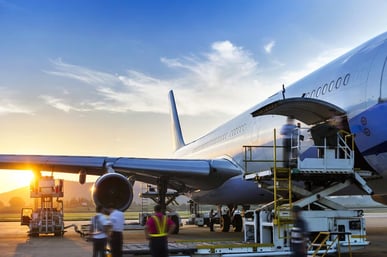The latest Xeneta data shows Europe to US air cargo spot rates picked up 7% month-on-month in February so far to reach USD 2.46 per kg – this is in contrast to other corridors, notably the Northeast Asia to the US market which has seen rate declines of 14%. Additionally, the Transatlantic spot rates showed 23% growth year-on-year, compared to 9% growth from Northeast Asia to the US.
.jpg?width=1280&height=720&name=Week%209%20Air%20Blog%20Chart%20(2).jpg)
The month-on-month growth in spot rates on the Transatlantic westbound corridor was partly driven by a post-holiday recovery in demand. In contrast, the double-digit year-on-year increase in spot rates was not fueled by a surge in demand or any inventory buildup in anticipation of US tariff hikes, but rather due to a capacity pull phenomenon.
Key Factors Behind Capacity Pull
One of the primary factors behind this phenomenon is the traditional reduction of belly capacity by carriers during winter. The belly capacity reaches a trough in February before gradually rising again from March.
The other primary factor is perhaps less traditional – namely the shift of dedicated freighter capacity from the Transatlantic corridor onto the more lucrative Asian market as carriers look to capitalize on the e-commerce boom.
Impact on spot rates
The Transatlantic capacity pull phenomenon means the dynamic load factor on this corridor (Xeneta’s measurement of capacity utilization based on volume and weight of cargo flown alongside available capacity) hovers around 80% in February, a similar level to the year-end peak season, which often indicates increased negotiating powers from freight sellers.
The result is a spot rate environment that maintains a gap of more than 70 cents above seasonal rates.
Navigating a complex trade environment
The freighter capacity shift away from Transatlantic market to Asia demonstrates the importance of shippers being aware of the risks posed by an increasingly complex global trade landscape.
The Trump administration’s tariff agenda, with its planned ad hoc “reciprocal” tariff on imports, add another layer of uncertainty. If tariffs are imposed with short notice, shippers will struggle to rush exports, limiting their ability to mitigate cost impacts. This could further dampen Transatlantic freight demand.
Locking in contracts without built-in contingency plans or flexible terms can lead to missed opportunities for securing lower air freight rates.
China tariffs and return of container ships to Red Sea
The sheer volume of goods being exported out of Asia means any escalation in the US-China trade war could indirectly impact the Transatlantic market.
For example, the colossal increases in cross-border e-commerce volumes out of China has been a crucial driver for global air cargo demand in 2024 and the capacity pull phenomenon highlighted earlier in this blog. However, a combination of post-year-end-retail peak season decline, Lunar New Year factory closures and Trump’s proposals to remove de minimis exemptions is slowing Transpacific air cargo demand. If Transpacific capacity loosens, the corridor’s spot rate growth may moderate, reducing the capacity pull from other major corridors such as the Transatlantic.
The picture is further complicated by another geo-political situation in the Middle East. A lasting ceasefire between Israel and Hamas could see a large-scale return of container ships to the Red Sea. In turn, this would result in some cargo currently being moved by air freight to avoid the disruption beginning to be shipped via ocean once again. This highlights again how disruptions in one region can impact global supply chains.
Strategic recommendations for shippers
In this volatile and complex environment, shippers should adopt a cautious yet flexible approach:
1. Monitor geopolitical and tariff developments:
Due to trade policy uncertainty, shippers should stay vigilant and closely monitor further changes in US tariff policies - not only those affecting Europe but also measures directed at other markets, such as China, which could alter the competitive landscape at a global level.
2. Delay long-term contract negotiations:
The combination of factors including the removal of de minimis exemptions, potential return of Red Sea container shipping and airlines’ seasonal capacity adjustments mean shippers could benefit from postponing negotiations for new contracts until Q2. Doing so could secure more competitive rates if the geo-political situation and markets turn in their favor.
3. Dynamic pricing models
.Use real-time benchmarking data to renegotiate terms and protect margins. Consider shifting from fixed-rate to index-linked contracts to better handle market volatility.
4. Strengthen supply chain resilience:
In an environment where capacity is tight and trade policies are in flux, diversifying vendors and enhancing inventory buffers become critical. Explore additional sourcing routes and diversifying export origins to reduce overreliance on single market.
Every market across both air and ocean modes is impacted by the current geo-political climate, so you are not alone if you are suffering from the uncertainty and volatility on the Transatlantic corridor.
However, it is something you need to get used to because this uncertainty is set to last. If you use air freight to transport your goods and want to retain competitive advantage, you must vigilantly monitor these policy changes. Xeneta’s data and intelligence is always available to inform your freight procurement strategy at a global, regional and airport level.






